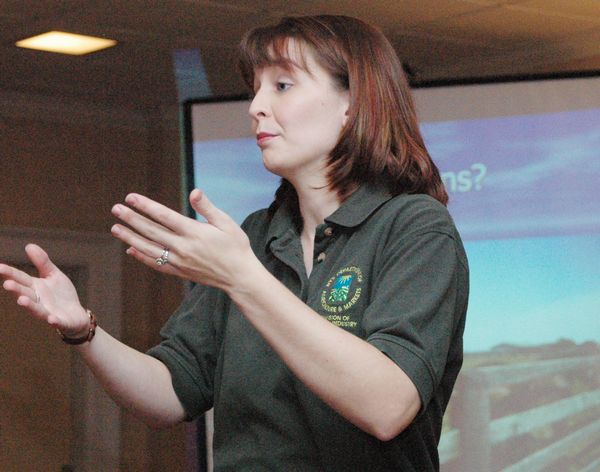Subscriptions
Menu
Advertisements
Ag & Markets outlines ID programs
10/24/2007 |
By Patsy Nicosia |

Two dozen farmers and others got a look at the state and federal livestock ID program Thursday at an Ag & Markets-sponsored information session in Cobleskill.
Called the New York State Animal Health Information System (NYAHIS) at the state level and the National Animal Identification System (NAIS) nationally, the still-voluntary programs are intended in part to help track and monitor disease outbreaks.
Sarah Blood-Szentmildosy, who grew up on a Cobleskill dairy farm, and Mary Grace Hoag, both of whom work for state Ag & Markets, started out by explaining first what the programs are not:
They’re not linked to the IRS, they don’t track sales records, they won’t shut down county fairs, they won’t put ear tags in horses, and they won’t use barcode tattoos.
Agriculture, Ms. Blood-Szentmildosy explained, needs protection from foreign and domestic diseases and needs to be able to contain them quickly, which she said the programs can do by registering premises—farms—and identifying animals through tags already in use.
Some of those at Thursday’s meeting had questions about how to “de-register” if they’d already signed up, fearful the information they provided, no matter how basic, could be used against them by animal rights activist or others.
Others pointed to the online posting of supposedly confidential provided to the United State Department of Agriculture, which administers everything from the school lunch program to emergency conservation aid.
Still others saw the point-of-origin piece of the programs as a way to let people know where their meat, for example, really comes from: Too often, China , said one man.
Getting out of the program requires submitting a change of information form—information that was included in the original registration packet and that’s also available at the USDA’s website, Ms. Blood-Szentmildosy and Ms. Hoag said.
The process takes a few months and the producer will have to confirm twice that he wants out of the program.
“How is that legal?” asked one man.
Ms. Blood-Szentmildosy answered that New York State has a longstanding practice of “knowing where animals are located” through such things as Coggins, TB, and brucellosis testing, and that’s a crucial part of the new ID and tracking effort.
“The difference now is that we’re taking that paperwork and putting it into a single data base,” she explained.
By way of a couple of stories, Ms. Blood-Szentmildosy explained how important it is to be able to do that quickly.
In one case, she said, she and Ms. Hoag were given an ear tag someone found at a county fair.
They spent weeks going through all sorts of Ag & Markets paper files, she said, before someone in the next office over realized it was a dog ear tag.
“If that was three weeks spent trying to track an animal because of a disease outbreak, the results could have been catastrophic,” she said. Ironic, because with internet access and 24-hour CNN, “Consumers may know about a disease outbreak before you do.”
New York has modified the USDA program for use here.
“We know dairy farmers don’t have time for additional recordkeeping,” Ms. Blood-Szentmildosy explained. “We’ll continue to utilize what’s already in place until something better comes along.”
That means using 911 addresses for listing farm locations and continuing to accept existing types of animal ID, including ear tags and DHIA numbers and even then, only when an animal leaves the farm.
Statewide, about 70 percent of farms are enrolled in the program. Nationwide, that figure is about 30 percent.









